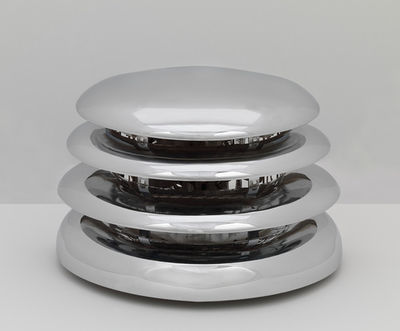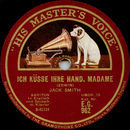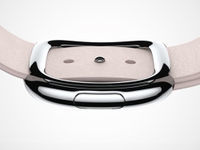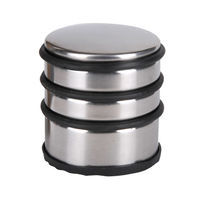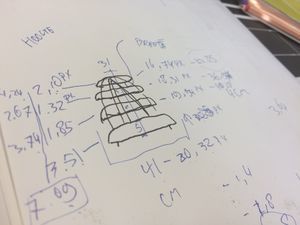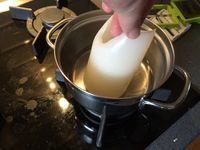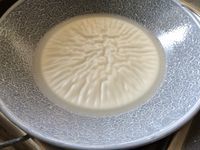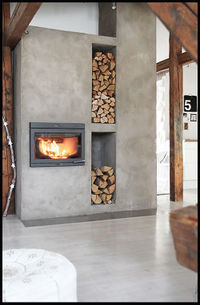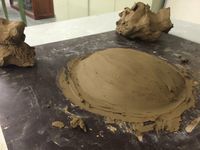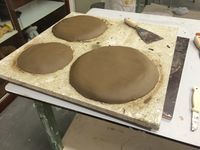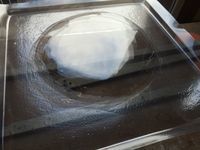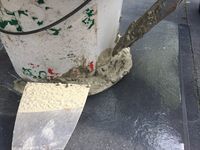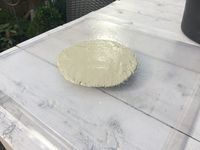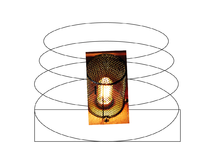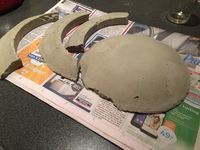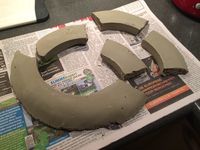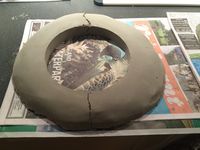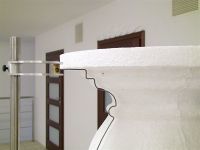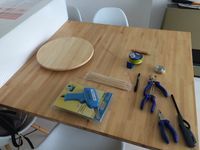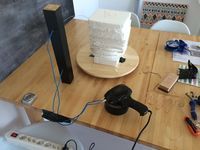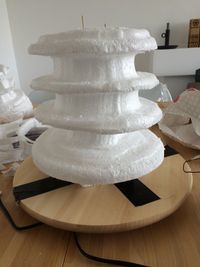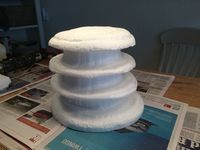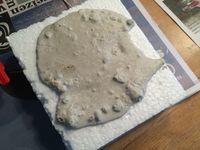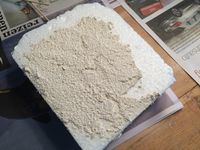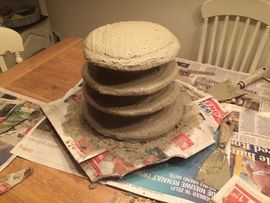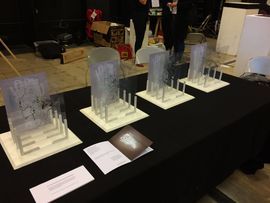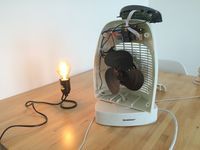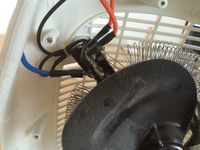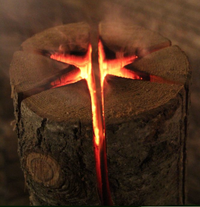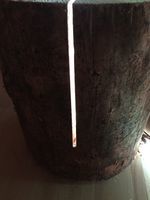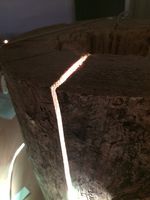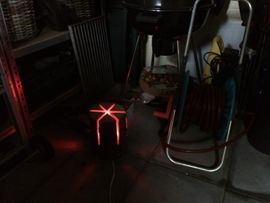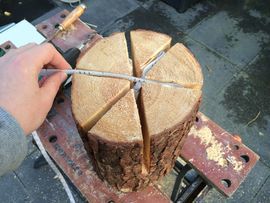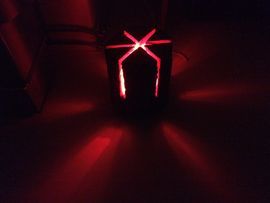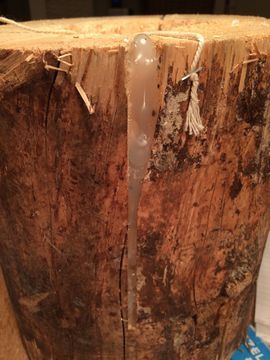Difference between revisions of "User:E.Stevens/pagename"
| (44 intermediate revisions by the same user not shown) | |||
| Line 49: | Line 49: | ||
De vormen van de heteluchtkachel van Barman lijken nog steeds gebruikt te worden. Het doet mij denken aan vormgeving van Apple producten; zoals bijvoorbeeld de Magic Mouse en de iWatch. | De vormen van de heteluchtkachel van Barman lijken nog steeds gebruikt te worden. Het doet mij denken aan vormgeving van Apple producten; zoals bijvoorbeeld de Magic Mouse en de iWatch. | ||
| − | [[File:Magicmouse.jpg | 200px]][[File:Iwatch.jpg | 200px]] | + | [[File:Magicmouse.jpg | 200px]][[File:Iwatch.jpg | 200px]][[File:1950216b.jpg | 200px]] |
De vormen leken voor mij overal in terug te komen. Zo zag ik de vormen terug in mijn deurstopper. | De vormen leken voor mij overal in terug te komen. Zo zag ik de vormen terug in mijn deurstopper. | ||
| − | |||
| − | |||
| − | |||
=Making of= | =Making of= | ||
| Line 77: | Line 74: | ||
Het eerst wat mij te binnen schoot was kaarsvet - niet te hebben gehoord dat een klasgenoot ook met kaarsvet werkt - om een gehele kachel van te maken. Nadat ik met verschillende docenten had gepraat begreep ik de opdracht pas goed. Kaarsvet gieten in een brede diepe pan was 'to easy' maar een test was er. | Het eerst wat mij te binnen schoot was kaarsvet - niet te hebben gehoord dat een klasgenoot ook met kaarsvet werkt - om een gehele kachel van te maken. Nadat ik met verschillende docenten had gepraat begreep ik de opdracht pas goed. Kaarsvet gieten in een brede diepe pan was 'to easy' maar een test was er. | ||
| − | [[File:2 .JPG | 200px]][File:4_EDWIN.JPG | 200px]] | + | [[File:2 .JPG | 200px]][[File:4_EDWIN.JPG | 200px]] |
| + | |||
| + | Kaarsvet liet ik even links liggen en kwam met het idee om de kachel van beton te maken. Ik bedacht mij dat kachels ruimtes opwarmen binnen betonnen muren, in de meeste gevallen. Daarnaast zie ik bijna nooit ronde voorwerpen van beton. Het materiaal fascineerde mij opeens. Vooral wanneer ik onderzoek ging doen naar beton, met in mijn achterhoofd dat beton in huis verwarmd wordt door een kachel. Alleen de vraag zwierf dagen rond in mijn hoofd; met wat ga ik de ronde vormingen van de kachel produceren? | ||
| + | |||
| + | [[File:Ingebouwde-kachel.jpg | 200px]] | ||
| + | |||
| + | Zonder enig verstand van beton ging ik naar de keramiek werkplaats, waar ik net als alle andere werkplaatsen maar één keer ben geweest. Ook zonder enige ervaring van de werkplaatsen. Als audiovisueel student zit je meer en deels in het blaak gebouw en maak je geen gebruik van de werkplaatsen, wat eigenlijk toch best zonde is. Gem, één van de keramiekdocenten, scheen enig verstand te hebben van beton, begreep ik van zijn collega's. Hij legde alles uit over beton en hielp mee met denken. De karakteristieke vormen van de kachel zou in beton niet tot zijn recht komen, vertelde Gem. Echter later liet hij mij de schijven van de kachel eerst in vorm kleien. De bedoeling was om de ronde schijven van de kachel in beton te gieten nadat ik met klei een mal had gevacuumd in de werkplaats. Vervolgens een cilinder in het midden te maken van een rooster en daarin een gloeidraad lamp. | ||
| + | |||
| + | [[File:6.jpeg | 200px]][[File:10.jpeg | 200px]][[File:12.jpeg | 200px]][[File:17.JPG | 200px]][[File:14.JPG | 200px]] | ||
| + | |||
| + | [[File:Ideekachel.png | 200px]][[File:IMG 5930.JPG | 200px]][[File:IMG 5931.JPG | 200px]][[File:IMG 5932.JPG | 200px]] | ||
| + | |||
| + | Eenmaal de mal te hebben gemaakt, goot ik beton in de vormen met als hulpmiddel een emmer die de vorm van de cilinder creëerde. Wat uurtjes later leek het beton hard te zijn om uit de mallen te halen. Jammer genoeg braken de schijven door midden in stukken. Dat zorgde voor vele vragen; teveel of juist te weinig water gebruikt? Het antwoord was simpel nadat ik Gem, de docent van keramiek, had gesproken. Wanneer je met beton in de breedte werkt moet je gebruik maken van staal die de beton bij elkaar houdt. Daarnaast zorgt beton ervoor dat het bovenste deel naar beneden drukt, zoals rechthoekige betonnen blokken. Tijdens de les van Tim begreep ik dat het knutselwerk, de vormen die ik in klein met mijn handen had gemaakt, niet de bedoeling was van de opdracht. Ik baalde verschrikkelijk aangezien er voor deze opdracht zo weinig tijd is en ik nu gigantisch tijd had verloren. Ik moest iets anders verzinnen om de vormen te creëren. Tim duwde mij de piepschuim kant op wat mij erg interessant leek. | ||
| + | |||
| + | [[File:CC70-D.jpg | 200px]][[File:Index.JPG | 200px]] | ||
| + | |||
| + | Met piepschuim kan je 'simpel' met warme draden snijden. De techniek bestaat er al een tijdje maar toch wordt er nog steeds geëxperimenteerd in nieuwe machines waar met draden verschillende egale vormen worden geproduceerd. De uitdaging was er voor mij om een nieuw systeem neer te zetten. Ik verdiepte mij meer in het solderen in piepschuim en kwam alleen maar uit bij hobbyisten die hun eigen decoratieve dingen maken voor hun modeltreinbaan. Na wat bezoeken in verschillende bouwmarkten kwam ik thuis met een soldeerpistool. In de ze pistool zitten twee ingangen waarmee je bijvoorbeeld een staaldraad in kan doen. Het idee was er om de vorm van de kachel te maken in koperdraad en vervolgens in de soldeerpistool te zetten. Een blok piepschuim zou op een draaiplateau moeten gaan draaien wanneer ik met een hete draad er langs zou gaan. Ik heb de soldeerpistool ongeveer vijf minuten in mijn handen gehad nog voordat hij er mee ophield. Inmiddels heb ik weer een soldeerpistool gekocht en ben ik van plan om de vorm van de draad kleinschaliger te maken om in het piepschuim te branden. | ||
| + | |||
| + | [[File:IMG 5961.JPG | 200px]][[File:IMG_5962.JPG | 200px]] | ||
| + | |||
| + | [[File:IMG_6027.JPG | 200px]][[File:IMG 6033.JPG | 200px]] | ||
| + | |||
| + | Helaas werkt mijn eigen gecreëerde systeem niet om doormiddel van een soldeerpistool twee schakeldraden aan te sluiten aan twee kroonsteentjes om die vervolgens te verbinden met een dunne stalen vorm draad. Het werd jammer genoeg niet heet genoeg om het piepschuim te snijden. De vormen maak ik nu met een kortere draad die ik vervolgens, wel met de hand, maak. | ||
| + | |||
| + | De opdracht werkt contra aangezien ik perfectionistisch ben en de lat altijd voor mezelf te hoog leg. In de audiovisuele circuit, bekend terrein, ben je nog in staat om achter je laptop in de nabewerking details te veranderen. Toch is het voor mij een perfecte manier om met deze minor en deze opdracht zo eens het onbekende te onderzoeken en misschien eens niet de focus te leggen op perfectionisme maar mijn onderzoek. Alhoewel het nog steeds blijft dat ik nooit tevreden ben over het eindresultaat. | ||
| + | |||
| + | [[File:IMG 6034.JPG | 200px]][[File:IMG_6035.JPG | 200px]] | ||
| + | |||
| + | De kachel is gesneden in piepschuim. Van het model kan ik helaas niet op korte termijn een mal maken. Ik heb besloten, om net als het storten bij een nieuwbouwhuis, het model van piepschuim in te smeren met beton. Ik kwam daarnaast nog groffe gebroken wit latex tegen die als pasta voor de muur dient. Ik heb wat testjes, hier boven te zien, gedaan op een blok piepschuim. | ||
| + | |||
| + | [[File:IMG 6036.JPG | 270px]][[File:IMG_6042.JPG | 270px]] | ||
| + | |||
| + | |||
| + | '''Transformatie''' | ||
| + | |||
| + | Ik ben nu van plan om voor de transformatie object bij de 'boomstam' plan te blijven zoals ik hierboven heb verteld. Aangezien mijn gekozen object (heteluchtkachel) zo tijdloos er uit ziet, kies ik ervoor om juist het tegenovergestelde materiaal te nemen. Het oorspronkelijke idee voor mijn transformatie slaagde jammer genoeg ook niet. Ik wilde gebruik maken van een werkende heteluchtkacheltje om vervolgens de warmte te projecteren. Ik haalde het plastic frame eraf en wilde de kachel in een boomstam verwerken. Het kacheltje sloot ik vervolgens weer aan. Helaas deed hij het maar een minuut waardoor hij voor mijn ogen kapot ging en de vonken eraf sprongen. | ||
| + | |||
| + | [[File:19.jpeg | 200px]][[File:20.jpeg | 200px]] | ||
| + | |||
| + | Het idee moest ik dus op korte termijn veranderen. Wat als ik de sfeer en de warmte zelf creëer in de boomstam? Dat zou makkelijk gaan in scheuren van boomstam. Daarin verwerk ik verschillende led lichten die ik dicht kit met transparante siliconen kit. Het licht zorgt voor een warme maar ook gezellige sfeer. | ||
| + | |||
| + | [[File:Schermafbeelding 2014-10-11 om 16.37.22.png | 200px]][[File:IMG_6022.JPG | 150px]][[File:IMG 6021.JPG | 150px]][[File:IMG_6042.jpeg | 270px]] | ||
| + | [[File:IMG_6038.JPG | 270px]][[File:IMG_6050.JPG | 270px]] | ||
| + | |||
| + | Helaas werkt de kit en zelfs de alternatief lijmpistool niet goed (even getest op een andere Zweedse fakkel). Zo is de transparante kit veel te hard om de kieren te vullen. Daarnaast is de lijm uit de pistool veel te warm waardoor de ledlichten kunnen beschadigen. | ||
| + | |||
| + | [[File:IMG 6048.JPG | 270px]][[File:IMG 6049.JPG | 270px]] | ||
| + | |||
| + | =Eindconclusie= | ||
| + | |||
| + | De tijdsdruk van het vele doen in een korte tijd was dan ook de reden waarom ik besloot om in de laatste weken twee eenvoudigen ideeën uit te werken. Ik kwam er eigenlijk pas later achter dat ik de uitdaging voor mezelf te groot had gemaakt. | ||
| + | Daarnaast ben ik '''buiten mijn comfort zone''' te werk gegaan en met onbekende materialen gewerkt. De werkplaatsen waren voor mij ook '''onbekend'''. Meerdere malen kreeg ik in de werkplaatsen te horen dat ik eerst les moest krijgen voordat ik met het materiaal of techniek kon werken. Dat creëerde veel stressmomenten op maar ook leermomenten. Het vissen naar informatie naar verschillende technieken werkte in het begin maar wanneer de deadline als maar dichterbij kwam besloot ik met vraagtekens aan het werk te gaan. | ||
| + | |||
| + | '''De link tussen mijn transformatie en replica''' zit in het onderwerp van de kachel zelf; warmte geven maar ook sfeer. Ik heb met beton gewerkt wat uiteindelijk juist een contra anti sfeer gaf aan het object waardoor ik koos om de transformatie juist met het materiaal te gebruiken wat tegenover beton staat; hout. Het eerste idee om de warmte van een kachel te projecteren in een boomstam mislukte helaas waardoor ik binnen korte tijd iets anders moest verzinnen. Ik kwam met het idee om van een boomstam een warmte bron te maken voor in huis door middel van het kweken van het warmte licht bij het branden van hout. | ||
| + | |||
| + | =Written Assignment= | ||
| + | |||
| + | *[[/pagename | (Lees hier de Nederlandse versie)]] | ||
| + | |||
| + | '''What is your craft? (define your discipline, method or approach)''' | ||
| + | |||
| + | My whole life I have been passionated about film; I love to capture my interests and fantasies. Not only capture this, but also conceptualize these ideas is something i’m passionate about. I have a long time love for the aftereffect of film (video-editing). As a filmmakker I would to leave a mark to touch the viewer, to enthuse, influence, and give a message to my work, and I would like to do this in my own way. I reach this through the right athmosphere. The right athmosphere for the viewer of film is in my opinion very important because it’s the way to feel connected to my stories. It’s a story I want to tell as a filmmaker. The technology I use for this is a original and catchy story, the right equipment and my own style and way of editing (postproduction). Next to the fact a good story is important, I like to use certain athmosphere in my films. An athmosphere can be put down by the use of certain colors, but also subtle details. Athmosphere is a wide understanding, but by using a certain athmosphere you can bring a feeling to the viewer that’s so much stronger than words. I find it important to use this strong tool to my work and it’s playing a big role, and you can definately see it back in my work. | ||
| + | |||
| + | I like to use a comic stylebrand to my work; absurdism. I prefer to call the viewers alienation and call a strange feeling. This use is meant as comic and witty. I like to touch the viewer with my work, but it’s one of my main goals to make people laugh. Nothing gives a better feeling than to hear people laugh about your work. I like, next to being a serious filmmaker with a absurd piece, to use a funny discharge as a strong meaning in my own work. I see myself as a serious filmmaker, but by using absurdism, I want to stand out and show people my creative self. | ||
| + | |||
| + | As a maker i’m looking for the effectiveness of simplicity, the craft, in combination with something new and something better. Think of the new technology that constantly is being improved for us. I always love a good concept, and work it out with a minimalistic view. | ||
| + | I’m always inspired by new technologies, where problems are being solved with or can be reduced by using these new technologies. | ||
| + | I work with old craft technologies like old filmcameras, or photograph with old rolls of film. With traditional methodes you can show different time phases but especially give the athmosphere of that time (nostalgia). I find that very interesting as a maker to work to enhance the story. I like to combine nostalgia with the modern time. I love gadgets, and new technologies, like new cameras, lenses, and edit technologies and programms. The simplicity from craft I try to use together with the new and modern, and finish it off by using the new technologies. I have a preference of minimalistic images, that look amazing and tell the viewer something. You can see that in nostalgia, but you also can see it in the modern time and it’s something I would like to bring over when I use the modern techniques. | ||
| + | |||
| + | |||
| + | '''What are the tools and media of your craft?''' | ||
| + | |||
| + | Within my audiovisual world we use equipment and devices to be able to explain everything. | ||
| + | The new methods and techniques of capturing every detail and emotion are improved every day. Almost everyone has a video camera at home which one captures something easy but the quality is not always guaranteed. Through my own creativity and specific ideas on how to see something in combination with creating my own style in combination with using my own equipment and programs for editing my work, I get my own voice out there. I design my own filters and design in post productions, and like this way I show my own style as a maker. With the help of using upload channels on internet such as Vimeo and Youtube, I show my work in public, so I reach my target audience and everyone can reach my work. | ||
| + | |||
| + | |||
| + | '''What are the borders of this practice? (what new media technologies have arisen / what is its future of the field))''' | ||
| + | |||
| + | The borders of a filmmaker are in my opinion privacy. In film you see beautiful stories, and stories being romanticized. There are “pretty” stories, even though the story is not pretty. All the misarable things are being told different of being edited off the film and very personal things are not being told or being withheld of the film. | ||
| + | The new technology is giving the privacy issue more and more attention and critism, and it’s giving a filmmaker the boundry he does not always want. With smartphones who document your life without the user knowing it. How will this all go in the future? Probably it will be more known that privacy does not excist. People want privacy, but it’s not there. The perfect picture of the human, but it’s not excisting. The boundry of the privacy question is still there right now. The boundry will be there and there will be critisism on violating it, but in the future it will be different, I think. As a filmmaker you can’t violate the privacy of an actor or the person you’re telling the story about and everything has to be approved first. Maybe this will change in the future, and privacy will not be such an issue anymore, in life and in film. | ||
| + | |||
| + | I want to do it all in my audivisual designs. But there is a boundry. I love to think about the concept, thinking it through, work the idea out, and film it all, and after that I want to edit in the post production. It’s my dream to do it all, and not stick to one thing in the process. But in practice it does not work like this. My experience is that I’m a piece in the total process. As an audiovisual designer you’re probably only the editor, and the rest of the project is being done by other creative people. It’s not your project or total picture anymore. I feel like this is a real boundry for me, because I have to make a creative decision I can’t make, because I love to make concepts, but also love to film and to edit. The future of the audivisual field is more competition of others, like graphic designers, artdirectors, but also big multinationals and advertising agencies. You somehow lose your creative freedom | ||
| + | Still I do believe there will be a place in the future for (nostalgic) crafts, and the effictivity of simplicity, which is also very important in my own work. I think this will come back not only in work, but also in the creative process and in (big) companies themself. When you work in the field it’s not always easy to work with many people within the same project and use complicated, expensive techniques and processes, like in the advertising world. | ||
| + | I hope there will be in the future a good combination of new techniques, with the love of old crafts and techniques, to come to a beautiful end result. | ||
| + | I hope the future will be less about the money a production is giving, but more about high quality. I believe how higher the quality, how higher you will eventually earn money. But it should not be the most important thing in design. In the future I hope the idea of “fast commercial making money” is disappearing and there will be a more important place for creativity and originality. | ||
| + | |||
| − | + | '''Connect to a historical discourse and give concrete examples of contemporary practitioners''' | |
| − | + | As a lover of hyper realistic art I like to watch the work of fine art artist Edward Hopper, known of his work ‘Nightawks’. Hoppers style reminds me of two (film) makers of this time; the Danish film and advertising director Roy Andersson and photographer Gregory Crewdson. All three use a silent, but also very realistic life as a startingpoint but also use the absurdist alienation what makes the work funny and comic. I find these works very inspirational, and it’s impressive how a fine art artist inspires a filmmaker and a photographer, but still have their own style and way to work, and they have different backgrounds and different time periods who still come together, despite the difference in technique, craft and background. | |
| − | |||
| − | + | '''Define your position of your practice in relation to newer technologies.''' | |
| − | + | Without the newer technolgies audiovisual design would not excist. I’m a filmmaker and a video editor, and especially with video editing I constantly use the newest programms and posibilities to make the best result as soon as possible. The techniques are faster, and you’re finishing the project faster, and because of these new techniques you can fasten the process. This is influencing me as a maker, but it also influence the creative field. Everything has to be quick, the deadlines are shorter, and the new technology will help me do this faster, but should not prevail the art. As a maker, I will be the most important supplier of quality, and I make the decisions. The choices I make, using the newest technology, will help me get the quality I want in the end and show the people what my qualities are as a designer or maker. | |
| − | + | Especially the modern globalisation is something that’s very important in my position. My work depends on globalisation. | |
| − | + | By the use of social media en the use of Vimeo and Youtube, it will be possible to be seen as a maker internationally, and to show my work on a wider audience. It influences me as a maker; the quality of my work has to be high because there is a lot of competition of other makers. It keeps you sharp, you can see what the competition is doing and what your place is in the market. It keeps you thinking about how to be original and stand above the competition. | |
| − | + | Without the modern technology and the internet, this would not be possible. If i would like to go to an important convention or exhibition of important, influential (film)makers, I have a possibility to go, no matter where it is in the world. Globalisation is a modern technology that influences me as maker, and what I can use as my inspiration, in my process, promotion of my work and more. In my position, I think the newer technologies are very important and without it, audiovisual design would not be as important in the art world as it is now. And with more technologies to come, I think my position and field will be more important in the future and I probably will have the oppertunity to improve my work and take it to the next level. | |
Latest revision as of 10:10, 29 October 2014
Contents
Informatie object
Maker: Christian Augustus Barman
Titel: His Master’s Voice (2e titel: HMV Room heater)
Jaar: 1934
Materiaal: Verchroomd plaatstaal en metaal
Dient als: Heteluchtkachel
Herkomst: Groot-Brittannië
Afmeting: (30.5 × 41.5 × 31 cm)
Aankoop Boijmans: 1983
Foto's
Onderzoek
Keuze
De heteluchtkachel van ontwerper Christian Augustus Barman staat in Boijmans tussen andere huishoudapparaten en viel voor mij direct op door de onversierde vormen en het chrome gebruik. Daarnaast zweef de vraag lang door mijn hoofd; hoe kan dit uit 1934 komen? Het object ziet er tijdloos uit, wat een enorm contrast vormt met de andere huishoudelijke apparaten, en dat maakt het interessant.
Maker
Barman ontwierp strijkijzers, haardrogers en andere huishoudelijke apparaten voor Morphy Richards, wat trouwens nog steeds bestaat. Vele ontwerpers in de jaren '30 waren geïnspireerd door het modernisme en ontwerpen vooral producten voor industriële klanten maar er was vraag naar simpele producten voor het huishouden. Via een omweg kom je er achter dat de kachel in de Art Deco stijlbeweging is bedacht en gemaakt. Zo omschrijft een verzamelaar over de heteluchtkachel: "Waarschijnlijk de beroemdste elektrische kachel, aanwezig in menig museum, waaronder Boijmans Van Beuningen en het Victoria & Albert. Een buitengewoon plastisch bibendum-achtig geval, een ontwerp van Christian Barman uit 1934, passend in de streamline-variant van de art deco en daarmee gelijkenis vertonend met bijvoorbeeld de grille van een Cord automobiel. De kwabben zijn ook nog dubbelwandig, het lijkt daardoor meer beeldhouwwerk dan plaatstaal." - Bron
De titel van het object His Master's Voice (afkorting HMV) is de naam van oude Engelse platenlabel uit 1899. Het platenlabel is al sinds de jaren '80 niet meer actief, maar de winkelketens bestaan nog. Het beeldmerk van HMV werd erg populair door het opvallende hondje, Nipper genaamd, voor een grammofoon. De reden waarom de heteluchtkachel van Barman de naam heeft gekregen van een platenlabel is voor mij nog onbekend.
Look a like
De vormen van de heteluchtkachel van Barman lijken nog steeds gebruikt te worden. Het doet mij denken aan vormgeving van Apple producten; zoals bijvoorbeeld de Magic Mouse en de iWatch.
De vormen leken voor mij overal in terug te komen. Zo zag ik de vormen terug in mijn deurstopper.
Making of
Ik wil graag het onderwerp warmte van de heteluchtkachel behouden, niet perse zijn functie maar meer de sfeer. Dat zie ik voor me als een lichtbron of ander element wat sfeer / warmte naar voren brengt. Daarnaast zijn de vormen van de kachel zijn karakter. Daar wil ik vooral met het materiaal mee spelen . Welk materiaal is daar geschikt voor om binnen korte termijn iets neer te zetten?
Allereerst begon ik alle maten per verdieping van de kachel uit te meten. De enige maten die ik had gevonden op internet waren maten van de hele kachel. Ik heb in Photoshop per pixel alles uitgemeten en kwam op de volgende maten per schijf:
- 1e schijf (breed: 33,85cm - hoog 4.24cm)
- 2e schijf (breed: 36,97cm - hoog 2.67cm)
- 3e schijf (breed: 40.28cm - hoog 3.74cm)
- 4e schijf (breed: 41cm - hoog 7.09cm)
Tegenslagen
Het eerst wat mij te binnen schoot was kaarsvet - niet te hebben gehoord dat een klasgenoot ook met kaarsvet werkt - om een gehele kachel van te maken. Nadat ik met verschillende docenten had gepraat begreep ik de opdracht pas goed. Kaarsvet gieten in een brede diepe pan was 'to easy' maar een test was er.
Kaarsvet liet ik even links liggen en kwam met het idee om de kachel van beton te maken. Ik bedacht mij dat kachels ruimtes opwarmen binnen betonnen muren, in de meeste gevallen. Daarnaast zie ik bijna nooit ronde voorwerpen van beton. Het materiaal fascineerde mij opeens. Vooral wanneer ik onderzoek ging doen naar beton, met in mijn achterhoofd dat beton in huis verwarmd wordt door een kachel. Alleen de vraag zwierf dagen rond in mijn hoofd; met wat ga ik de ronde vormingen van de kachel produceren?
Zonder enig verstand van beton ging ik naar de keramiek werkplaats, waar ik net als alle andere werkplaatsen maar één keer ben geweest. Ook zonder enige ervaring van de werkplaatsen. Als audiovisueel student zit je meer en deels in het blaak gebouw en maak je geen gebruik van de werkplaatsen, wat eigenlijk toch best zonde is. Gem, één van de keramiekdocenten, scheen enig verstand te hebben van beton, begreep ik van zijn collega's. Hij legde alles uit over beton en hielp mee met denken. De karakteristieke vormen van de kachel zou in beton niet tot zijn recht komen, vertelde Gem. Echter later liet hij mij de schijven van de kachel eerst in vorm kleien. De bedoeling was om de ronde schijven van de kachel in beton te gieten nadat ik met klei een mal had gevacuumd in de werkplaats. Vervolgens een cilinder in het midden te maken van een rooster en daarin een gloeidraad lamp.
Eenmaal de mal te hebben gemaakt, goot ik beton in de vormen met als hulpmiddel een emmer die de vorm van de cilinder creëerde. Wat uurtjes later leek het beton hard te zijn om uit de mallen te halen. Jammer genoeg braken de schijven door midden in stukken. Dat zorgde voor vele vragen; teveel of juist te weinig water gebruikt? Het antwoord was simpel nadat ik Gem, de docent van keramiek, had gesproken. Wanneer je met beton in de breedte werkt moet je gebruik maken van staal die de beton bij elkaar houdt. Daarnaast zorgt beton ervoor dat het bovenste deel naar beneden drukt, zoals rechthoekige betonnen blokken. Tijdens de les van Tim begreep ik dat het knutselwerk, de vormen die ik in klein met mijn handen had gemaakt, niet de bedoeling was van de opdracht. Ik baalde verschrikkelijk aangezien er voor deze opdracht zo weinig tijd is en ik nu gigantisch tijd had verloren. Ik moest iets anders verzinnen om de vormen te creëren. Tim duwde mij de piepschuim kant op wat mij erg interessant leek.
Met piepschuim kan je 'simpel' met warme draden snijden. De techniek bestaat er al een tijdje maar toch wordt er nog steeds geëxperimenteerd in nieuwe machines waar met draden verschillende egale vormen worden geproduceerd. De uitdaging was er voor mij om een nieuw systeem neer te zetten. Ik verdiepte mij meer in het solderen in piepschuim en kwam alleen maar uit bij hobbyisten die hun eigen decoratieve dingen maken voor hun modeltreinbaan. Na wat bezoeken in verschillende bouwmarkten kwam ik thuis met een soldeerpistool. In de ze pistool zitten twee ingangen waarmee je bijvoorbeeld een staaldraad in kan doen. Het idee was er om de vorm van de kachel te maken in koperdraad en vervolgens in de soldeerpistool te zetten. Een blok piepschuim zou op een draaiplateau moeten gaan draaien wanneer ik met een hete draad er langs zou gaan. Ik heb de soldeerpistool ongeveer vijf minuten in mijn handen gehad nog voordat hij er mee ophield. Inmiddels heb ik weer een soldeerpistool gekocht en ben ik van plan om de vorm van de draad kleinschaliger te maken om in het piepschuim te branden.
Helaas werkt mijn eigen gecreëerde systeem niet om doormiddel van een soldeerpistool twee schakeldraden aan te sluiten aan twee kroonsteentjes om die vervolgens te verbinden met een dunne stalen vorm draad. Het werd jammer genoeg niet heet genoeg om het piepschuim te snijden. De vormen maak ik nu met een kortere draad die ik vervolgens, wel met de hand, maak.
De opdracht werkt contra aangezien ik perfectionistisch ben en de lat altijd voor mezelf te hoog leg. In de audiovisuele circuit, bekend terrein, ben je nog in staat om achter je laptop in de nabewerking details te veranderen. Toch is het voor mij een perfecte manier om met deze minor en deze opdracht zo eens het onbekende te onderzoeken en misschien eens niet de focus te leggen op perfectionisme maar mijn onderzoek. Alhoewel het nog steeds blijft dat ik nooit tevreden ben over het eindresultaat.
De kachel is gesneden in piepschuim. Van het model kan ik helaas niet op korte termijn een mal maken. Ik heb besloten, om net als het storten bij een nieuwbouwhuis, het model van piepschuim in te smeren met beton. Ik kwam daarnaast nog groffe gebroken wit latex tegen die als pasta voor de muur dient. Ik heb wat testjes, hier boven te zien, gedaan op een blok piepschuim.
Transformatie
Ik ben nu van plan om voor de transformatie object bij de 'boomstam' plan te blijven zoals ik hierboven heb verteld. Aangezien mijn gekozen object (heteluchtkachel) zo tijdloos er uit ziet, kies ik ervoor om juist het tegenovergestelde materiaal te nemen. Het oorspronkelijke idee voor mijn transformatie slaagde jammer genoeg ook niet. Ik wilde gebruik maken van een werkende heteluchtkacheltje om vervolgens de warmte te projecteren. Ik haalde het plastic frame eraf en wilde de kachel in een boomstam verwerken. Het kacheltje sloot ik vervolgens weer aan. Helaas deed hij het maar een minuut waardoor hij voor mijn ogen kapot ging en de vonken eraf sprongen.
Het idee moest ik dus op korte termijn veranderen. Wat als ik de sfeer en de warmte zelf creëer in de boomstam? Dat zou makkelijk gaan in scheuren van boomstam. Daarin verwerk ik verschillende led lichten die ik dicht kit met transparante siliconen kit. Het licht zorgt voor een warme maar ook gezellige sfeer.
Helaas werkt de kit en zelfs de alternatief lijmpistool niet goed (even getest op een andere Zweedse fakkel). Zo is de transparante kit veel te hard om de kieren te vullen. Daarnaast is de lijm uit de pistool veel te warm waardoor de ledlichten kunnen beschadigen.
Eindconclusie
De tijdsdruk van het vele doen in een korte tijd was dan ook de reden waarom ik besloot om in de laatste weken twee eenvoudigen ideeën uit te werken. Ik kwam er eigenlijk pas later achter dat ik de uitdaging voor mezelf te groot had gemaakt. Daarnaast ben ik buiten mijn comfort zone te werk gegaan en met onbekende materialen gewerkt. De werkplaatsen waren voor mij ook onbekend. Meerdere malen kreeg ik in de werkplaatsen te horen dat ik eerst les moest krijgen voordat ik met het materiaal of techniek kon werken. Dat creëerde veel stressmomenten op maar ook leermomenten. Het vissen naar informatie naar verschillende technieken werkte in het begin maar wanneer de deadline als maar dichterbij kwam besloot ik met vraagtekens aan het werk te gaan.
De link tussen mijn transformatie en replica zit in het onderwerp van de kachel zelf; warmte geven maar ook sfeer. Ik heb met beton gewerkt wat uiteindelijk juist een contra anti sfeer gaf aan het object waardoor ik koos om de transformatie juist met het materiaal te gebruiken wat tegenover beton staat; hout. Het eerste idee om de warmte van een kachel te projecteren in een boomstam mislukte helaas waardoor ik binnen korte tijd iets anders moest verzinnen. Ik kwam met het idee om van een boomstam een warmte bron te maken voor in huis door middel van het kweken van het warmte licht bij het branden van hout.
Written Assignment
What is your craft? (define your discipline, method or approach)
My whole life I have been passionated about film; I love to capture my interests and fantasies. Not only capture this, but also conceptualize these ideas is something i’m passionate about. I have a long time love for the aftereffect of film (video-editing). As a filmmakker I would to leave a mark to touch the viewer, to enthuse, influence, and give a message to my work, and I would like to do this in my own way. I reach this through the right athmosphere. The right athmosphere for the viewer of film is in my opinion very important because it’s the way to feel connected to my stories. It’s a story I want to tell as a filmmaker. The technology I use for this is a original and catchy story, the right equipment and my own style and way of editing (postproduction). Next to the fact a good story is important, I like to use certain athmosphere in my films. An athmosphere can be put down by the use of certain colors, but also subtle details. Athmosphere is a wide understanding, but by using a certain athmosphere you can bring a feeling to the viewer that’s so much stronger than words. I find it important to use this strong tool to my work and it’s playing a big role, and you can definately see it back in my work.
I like to use a comic stylebrand to my work; absurdism. I prefer to call the viewers alienation and call a strange feeling. This use is meant as comic and witty. I like to touch the viewer with my work, but it’s one of my main goals to make people laugh. Nothing gives a better feeling than to hear people laugh about your work. I like, next to being a serious filmmaker with a absurd piece, to use a funny discharge as a strong meaning in my own work. I see myself as a serious filmmaker, but by using absurdism, I want to stand out and show people my creative self.
As a maker i’m looking for the effectiveness of simplicity, the craft, in combination with something new and something better. Think of the new technology that constantly is being improved for us. I always love a good concept, and work it out with a minimalistic view. I’m always inspired by new technologies, where problems are being solved with or can be reduced by using these new technologies. I work with old craft technologies like old filmcameras, or photograph with old rolls of film. With traditional methodes you can show different time phases but especially give the athmosphere of that time (nostalgia). I find that very interesting as a maker to work to enhance the story. I like to combine nostalgia with the modern time. I love gadgets, and new technologies, like new cameras, lenses, and edit technologies and programms. The simplicity from craft I try to use together with the new and modern, and finish it off by using the new technologies. I have a preference of minimalistic images, that look amazing and tell the viewer something. You can see that in nostalgia, but you also can see it in the modern time and it’s something I would like to bring over when I use the modern techniques.
What are the tools and media of your craft?
Within my audiovisual world we use equipment and devices to be able to explain everything. The new methods and techniques of capturing every detail and emotion are improved every day. Almost everyone has a video camera at home which one captures something easy but the quality is not always guaranteed. Through my own creativity and specific ideas on how to see something in combination with creating my own style in combination with using my own equipment and programs for editing my work, I get my own voice out there. I design my own filters and design in post productions, and like this way I show my own style as a maker. With the help of using upload channels on internet such as Vimeo and Youtube, I show my work in public, so I reach my target audience and everyone can reach my work.
What are the borders of this practice? (what new media technologies have arisen / what is its future of the field))
The borders of a filmmaker are in my opinion privacy. In film you see beautiful stories, and stories being romanticized. There are “pretty” stories, even though the story is not pretty. All the misarable things are being told different of being edited off the film and very personal things are not being told or being withheld of the film. The new technology is giving the privacy issue more and more attention and critism, and it’s giving a filmmaker the boundry he does not always want. With smartphones who document your life without the user knowing it. How will this all go in the future? Probably it will be more known that privacy does not excist. People want privacy, but it’s not there. The perfect picture of the human, but it’s not excisting. The boundry of the privacy question is still there right now. The boundry will be there and there will be critisism on violating it, but in the future it will be different, I think. As a filmmaker you can’t violate the privacy of an actor or the person you’re telling the story about and everything has to be approved first. Maybe this will change in the future, and privacy will not be such an issue anymore, in life and in film.
I want to do it all in my audivisual designs. But there is a boundry. I love to think about the concept, thinking it through, work the idea out, and film it all, and after that I want to edit in the post production. It’s my dream to do it all, and not stick to one thing in the process. But in practice it does not work like this. My experience is that I’m a piece in the total process. As an audiovisual designer you’re probably only the editor, and the rest of the project is being done by other creative people. It’s not your project or total picture anymore. I feel like this is a real boundry for me, because I have to make a creative decision I can’t make, because I love to make concepts, but also love to film and to edit. The future of the audivisual field is more competition of others, like graphic designers, artdirectors, but also big multinationals and advertising agencies. You somehow lose your creative freedom Still I do believe there will be a place in the future for (nostalgic) crafts, and the effictivity of simplicity, which is also very important in my own work. I think this will come back not only in work, but also in the creative process and in (big) companies themself. When you work in the field it’s not always easy to work with many people within the same project and use complicated, expensive techniques and processes, like in the advertising world. I hope there will be in the future a good combination of new techniques, with the love of old crafts and techniques, to come to a beautiful end result. I hope the future will be less about the money a production is giving, but more about high quality. I believe how higher the quality, how higher you will eventually earn money. But it should not be the most important thing in design. In the future I hope the idea of “fast commercial making money” is disappearing and there will be a more important place for creativity and originality.
Connect to a historical discourse and give concrete examples of contemporary practitioners
As a lover of hyper realistic art I like to watch the work of fine art artist Edward Hopper, known of his work ‘Nightawks’. Hoppers style reminds me of two (film) makers of this time; the Danish film and advertising director Roy Andersson and photographer Gregory Crewdson. All three use a silent, but also very realistic life as a startingpoint but also use the absurdist alienation what makes the work funny and comic. I find these works very inspirational, and it’s impressive how a fine art artist inspires a filmmaker and a photographer, but still have their own style and way to work, and they have different backgrounds and different time periods who still come together, despite the difference in technique, craft and background.
Define your position of your practice in relation to newer technologies.
Without the newer technolgies audiovisual design would not excist. I’m a filmmaker and a video editor, and especially with video editing I constantly use the newest programms and posibilities to make the best result as soon as possible. The techniques are faster, and you’re finishing the project faster, and because of these new techniques you can fasten the process. This is influencing me as a maker, but it also influence the creative field. Everything has to be quick, the deadlines are shorter, and the new technology will help me do this faster, but should not prevail the art. As a maker, I will be the most important supplier of quality, and I make the decisions. The choices I make, using the newest technology, will help me get the quality I want in the end and show the people what my qualities are as a designer or maker.
Especially the modern globalisation is something that’s very important in my position. My work depends on globalisation. By the use of social media en the use of Vimeo and Youtube, it will be possible to be seen as a maker internationally, and to show my work on a wider audience. It influences me as a maker; the quality of my work has to be high because there is a lot of competition of other makers. It keeps you sharp, you can see what the competition is doing and what your place is in the market. It keeps you thinking about how to be original and stand above the competition. Without the modern technology and the internet, this would not be possible. If i would like to go to an important convention or exhibition of important, influential (film)makers, I have a possibility to go, no matter where it is in the world. Globalisation is a modern technology that influences me as maker, and what I can use as my inspiration, in my process, promotion of my work and more. In my position, I think the newer technologies are very important and without it, audiovisual design would not be as important in the art world as it is now. And with more technologies to come, I think my position and field will be more important in the future and I probably will have the oppertunity to improve my work and take it to the next level.
